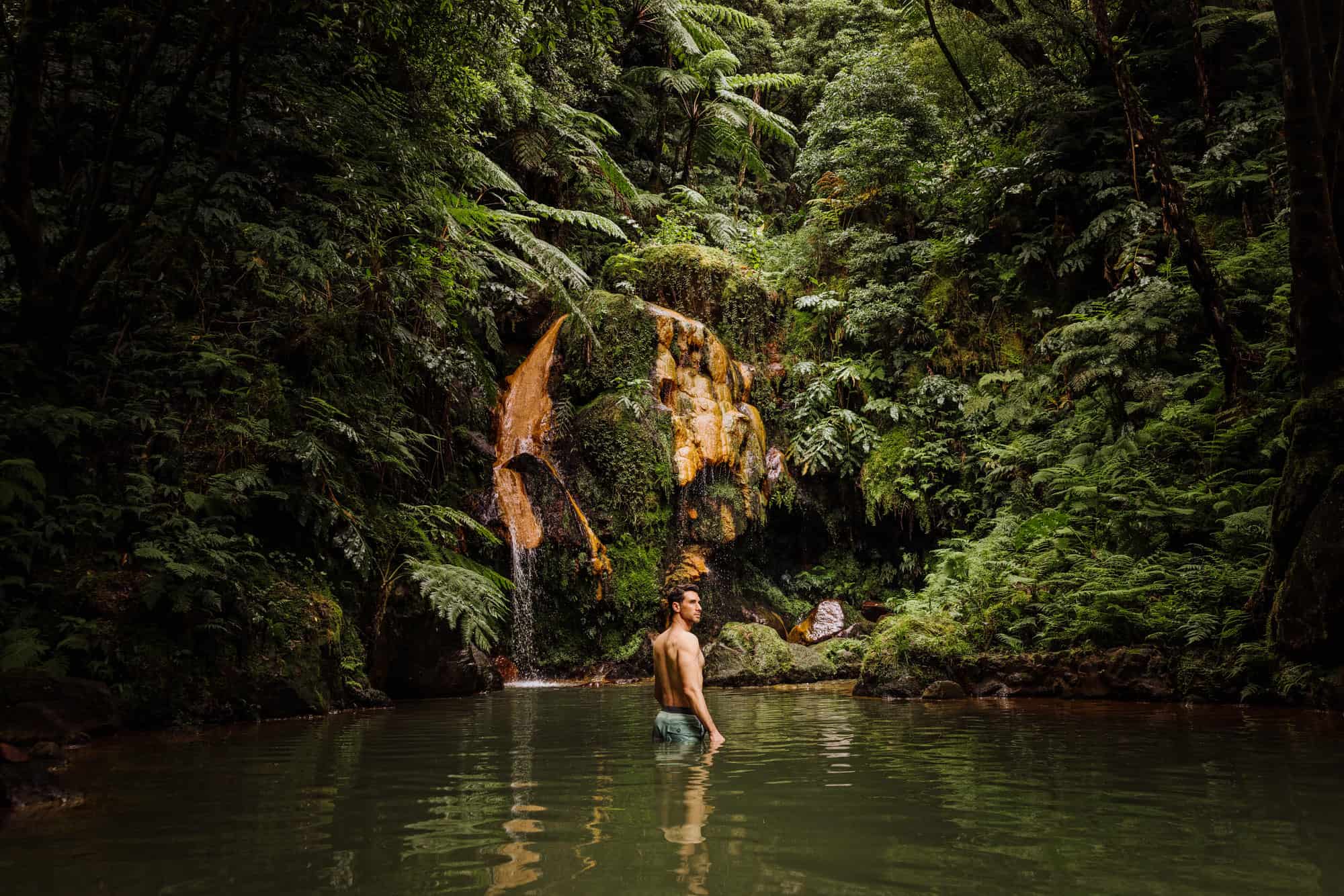Azores Hot Springs: The 5 Best on Sao Miguel

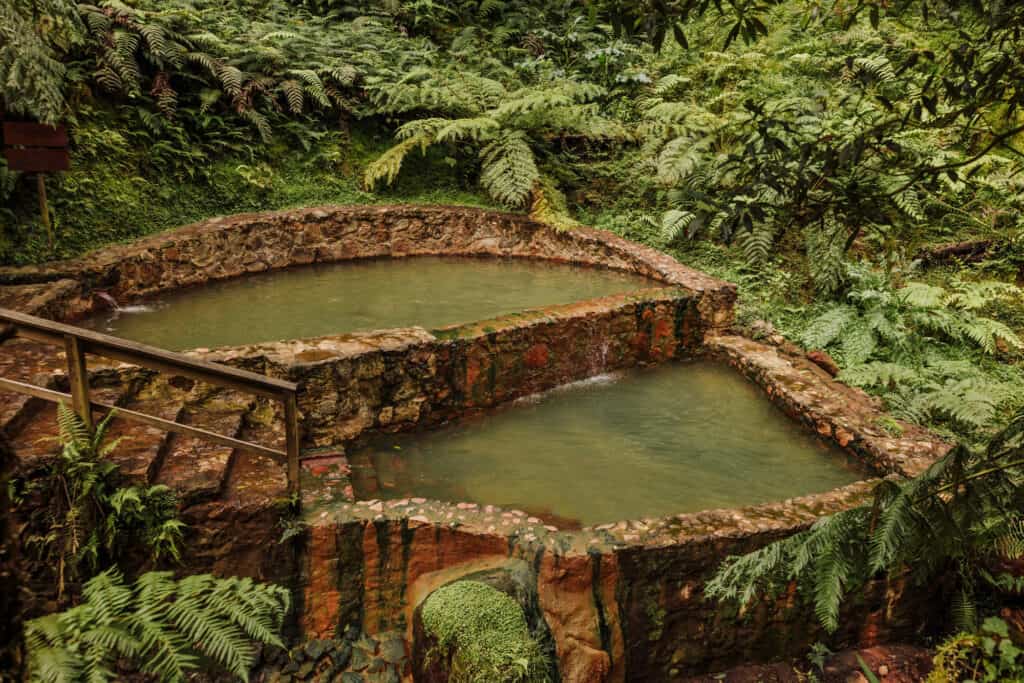
AZORES HOT SPRINGS: THE BEST OF SAO MIGUEL
The Azores’ hot springs are a major draw, for locals and tourists alike on São Miguel Island.
The island chain in the Atlantic sits on a tectonic plate boundary where the Eurasian and North American plates meet. Volcanic activity beneath the surface heats the groundwater, resulting in hot springs in stunning settings.
Each São Miguel hot spring is different and unique, so let’s go through them to see which you’d like to visit on a trip to the Azores!
How to get to the Azores Hot Springs
There are basically two ways to get to São Miguel’s hot springs. You can rent a car, or take a tour from the city of Ponta Delgada.
I’d suggest renting a car in the Azores, because it’s cost-effective and efficient.
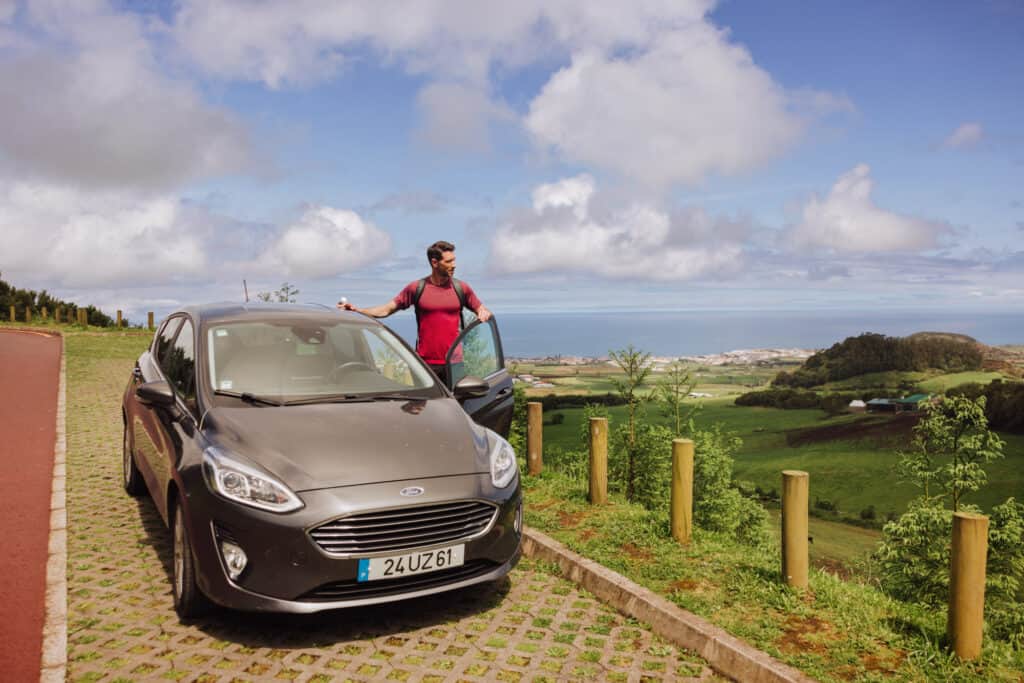
São Miguel Hot Springs Tours
On the other hand, I completely understand if you’re not comfortable dealing with the hassle of renting a car in a foreign country. You’re in luck, since there are a number of Azores hot springs tours to choose from.
Here are few tours of the different São Miguel hot springs to check out, which all have excellent reviews:
➡️ Click to Book: Azores Hot Springs + Volcano Tour
- You’ll see amazing views and take a dip in the Caldeira Velha hot springs on this tour.
➡️ Click to Book: The Azores Hot Springs a Night
- Poca da Dona Beija is a popular spot to hit at night in Furnas. This tour includes the hot springs plus a dinner.
➡️ Click to Book: Full Day Tour of São Miguel
- See the island’s best sites, including a hot spring in Furnas, in a full day tour
➡️ Click to Book: Private Tour of São Miguel
- A private driver and guide will take you to the hot springs and the best sites on São Miguel.
OK, let’s get to the 5 Best Azores Hot Springs!
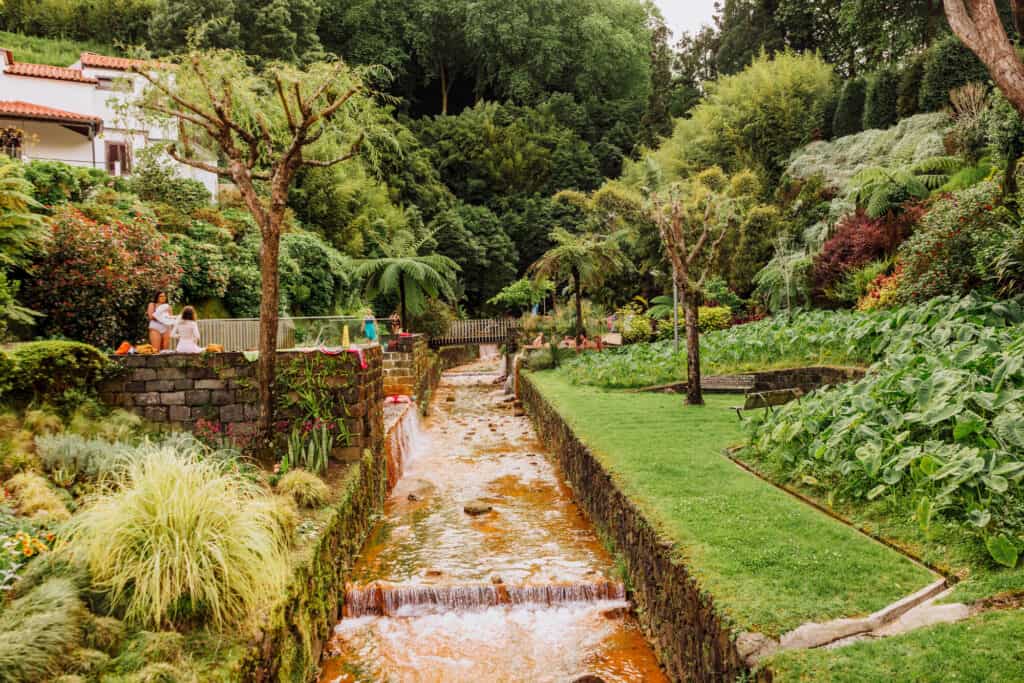
1. Poca da Dona Beija Hot Springs
Poca da Dona Beija is the most touristy of the Azores hot springs on São Miguel Island. Expect a crowd!
Still, people seem to love this series of five hot spring pools. You’ll find them in the bustling little town of Furnas, which is famous for its hot springs and other thermal and volcanic features.
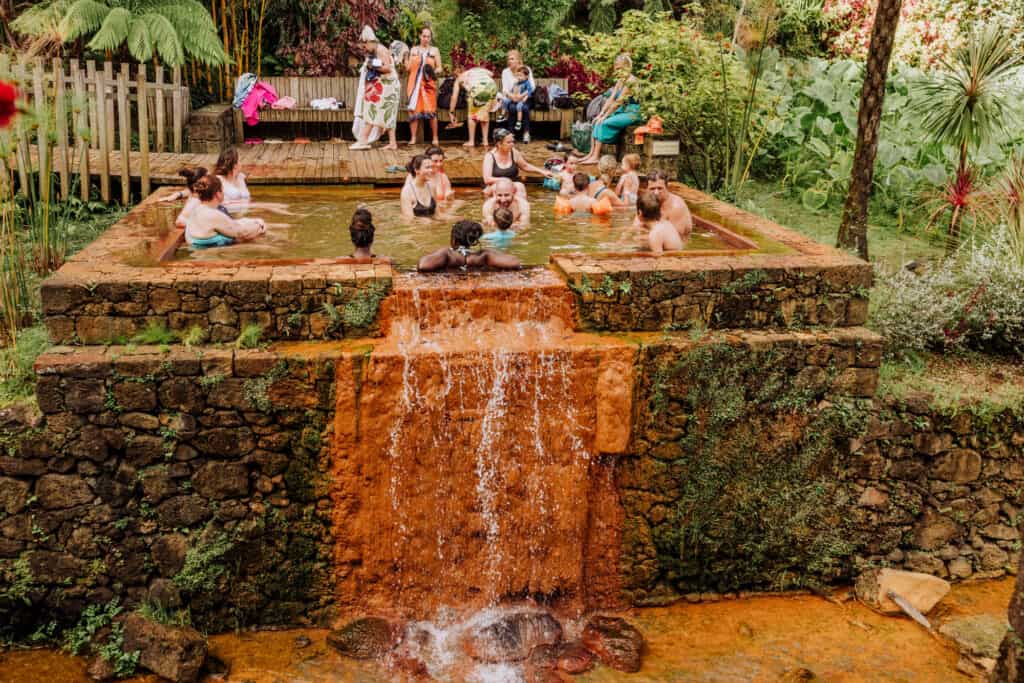
What sets Poca da Dona Beija apart is: these hot springs are open late-night, with the final entry at 10:00pm. In fact, they’re busiest after dark, with lines often forming at the gate with people waiting to get in. The hot springs close at 11:00pm.
You’ll get a wristband when you enter, and each person can bathe in the springs for 90 minutes.
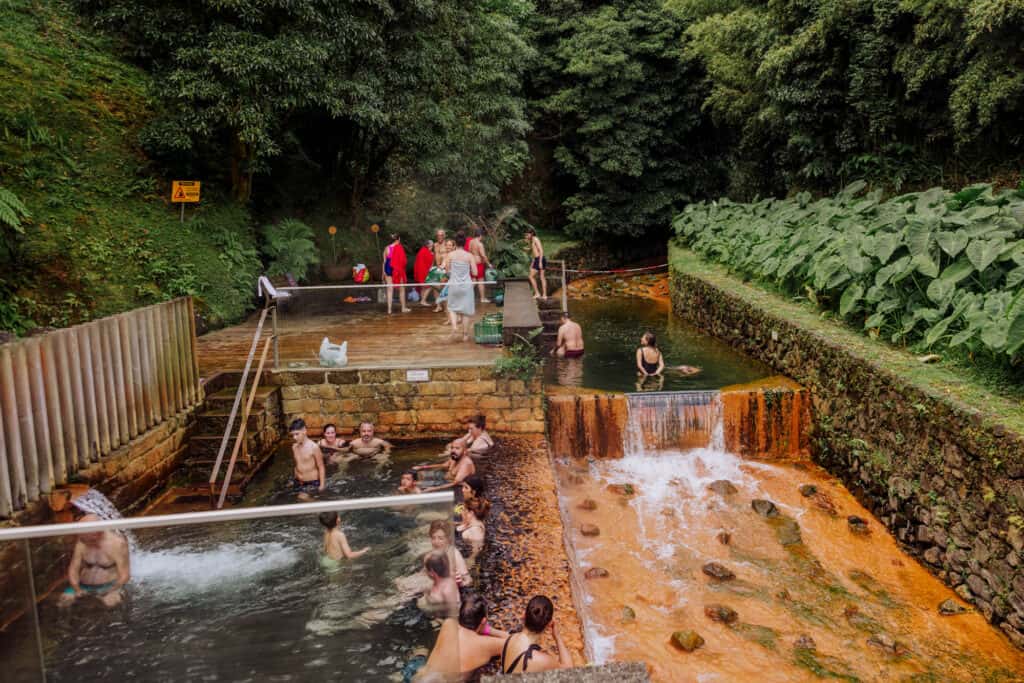
The five hot springs to swim in at Poca da Dona Beija are:
- Meditacao: 4.3 feet deep & 39 degrees Celcius (102F)
- Convivio Termai: 1-2 feet deep & 39 degrees Celcius (102F)
- Mistica: 3 feet deep & 39 degrees Celcius (102F)
- Serena: 2.6 feet deep & 39 degrees Celcius (102F)
- Riberia: 3.1 feet deep & 28 degrees Celcius (83F)
Poca da Dona Beija is really a communal bathing experience. The water is always moving naturally, so it’s constantly refreshing and cleaning the pools.
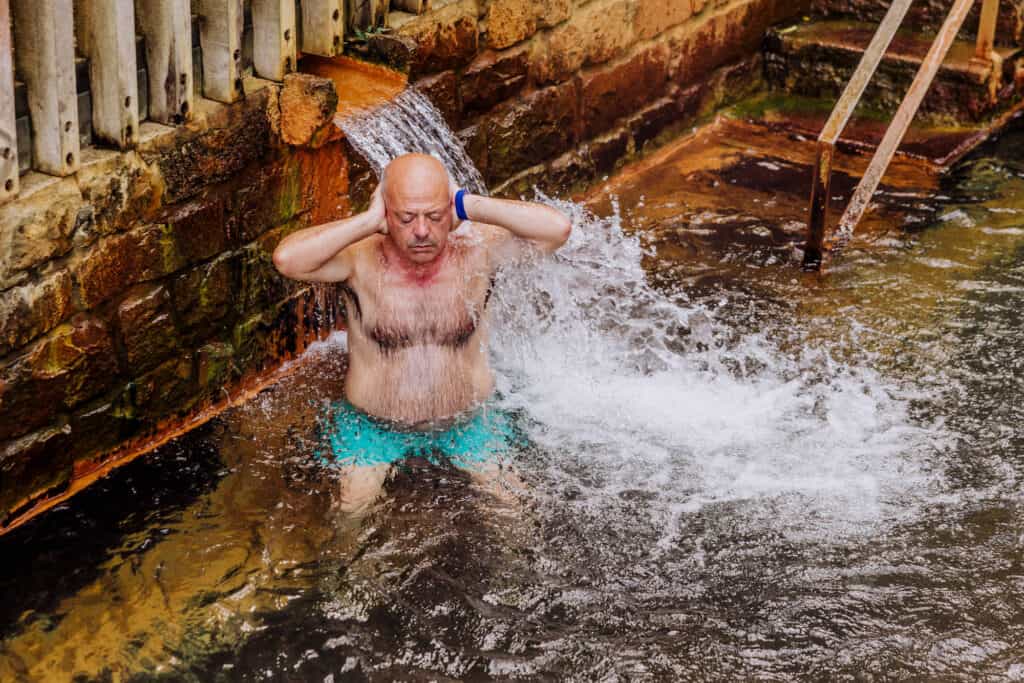
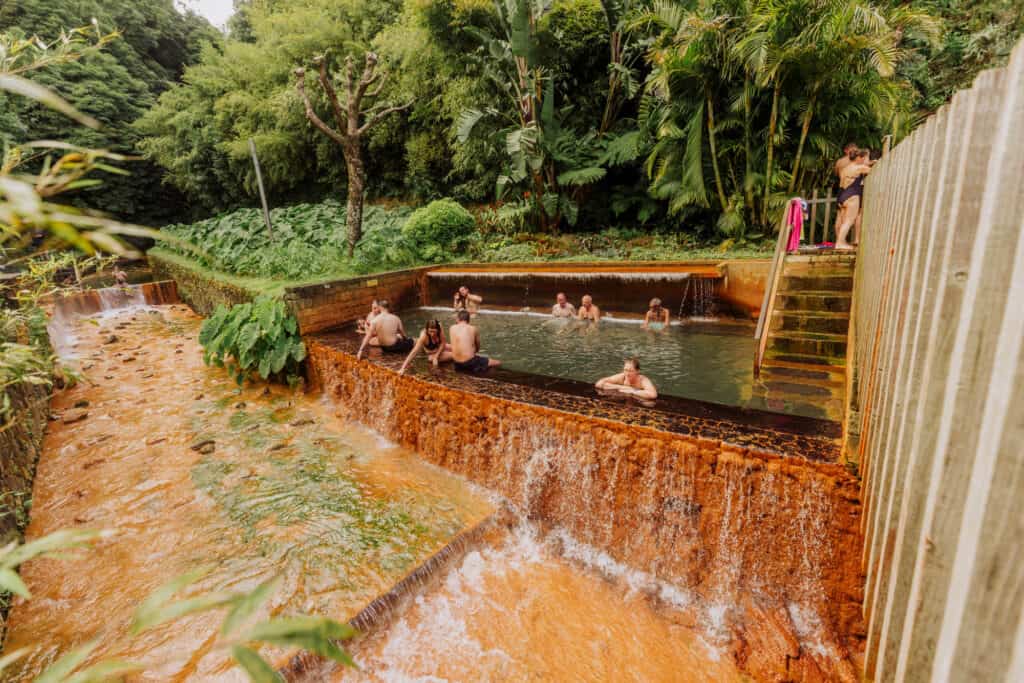
You’ll notice the orange sulfur collecting on the hot springs’ edges. People will slather that on their skin for purification.
There are showers and lockers on site to clean off in. You can keep a towel and fresh set of clothing there for after you’re done in the hot spring pools.
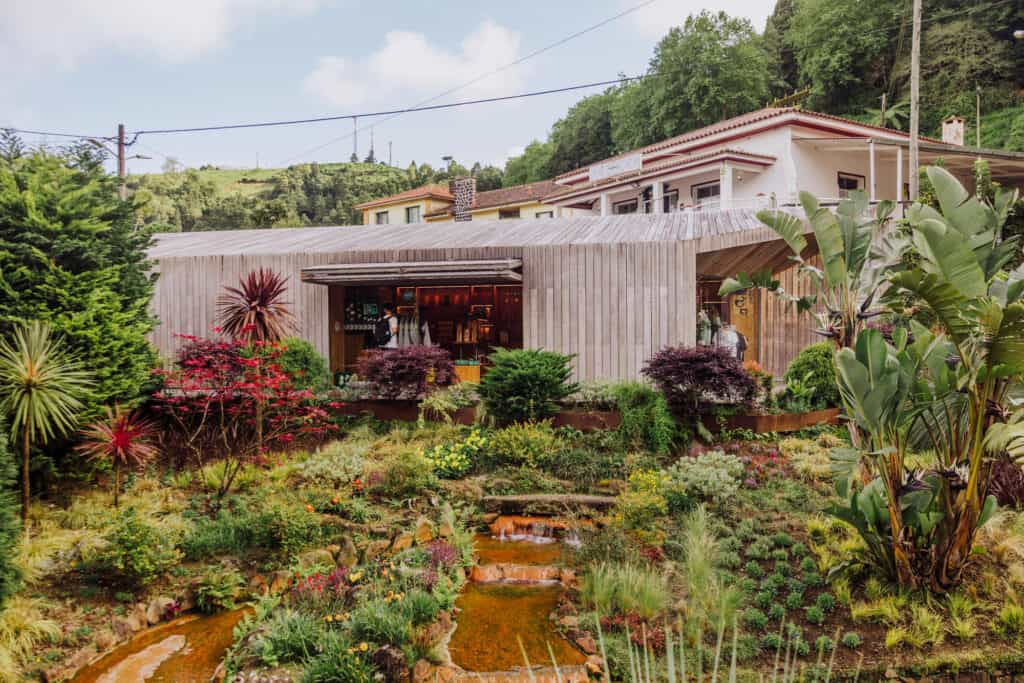
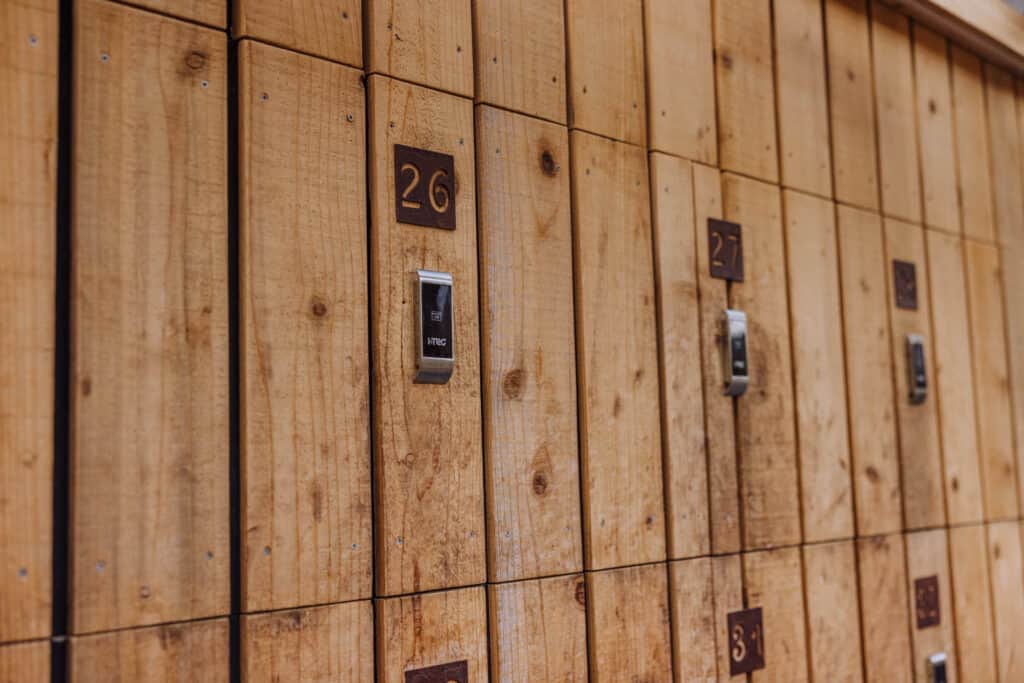
PRO TIP: Visit on a rainy day, since the crowds are much smaller. Plus, you’ll be in the hot springs pools, so it doesn’t really matter if it’s raining!
Water Temperature:
- 39C/102F for four of the five pools
- 28C/83F for the fifth
Poca da Dona Beija Cost:
- 8 Euros for adults
- 6 Euros for kids six and under
- 4 Euros for a towel
- 2 Euros for a locker
- 1 Euro fee for a hot shower after you leave the hot springs
Poca da Dona Beija Hours:
- Opens at 8:30am
- Last Entry at 10:00pm
- Open until 11:00pm
Amenities:
- Lockers, showers, snack bar, and souvenir shop
Hotel Nearby:
- Since Furnas is a nice town with multiple options for hotels an rentals, you can use this interactive map to see what’s available for your dates:
2. Terra Nostra Hot Springs
Terra Nostra is a renowned botanical garden and thermal resort located in Furnas, on São Miguel Island. It’s one of the most famous Azores hot springs.
The famous thermal bath at Terra Nostra is the big draw. The huge, orange thermal pool measures 35 meters (115 feet) across. The water in the pool is a distinctive reddish-brown-orange, due to the iron-rich minerals in the hot springs.
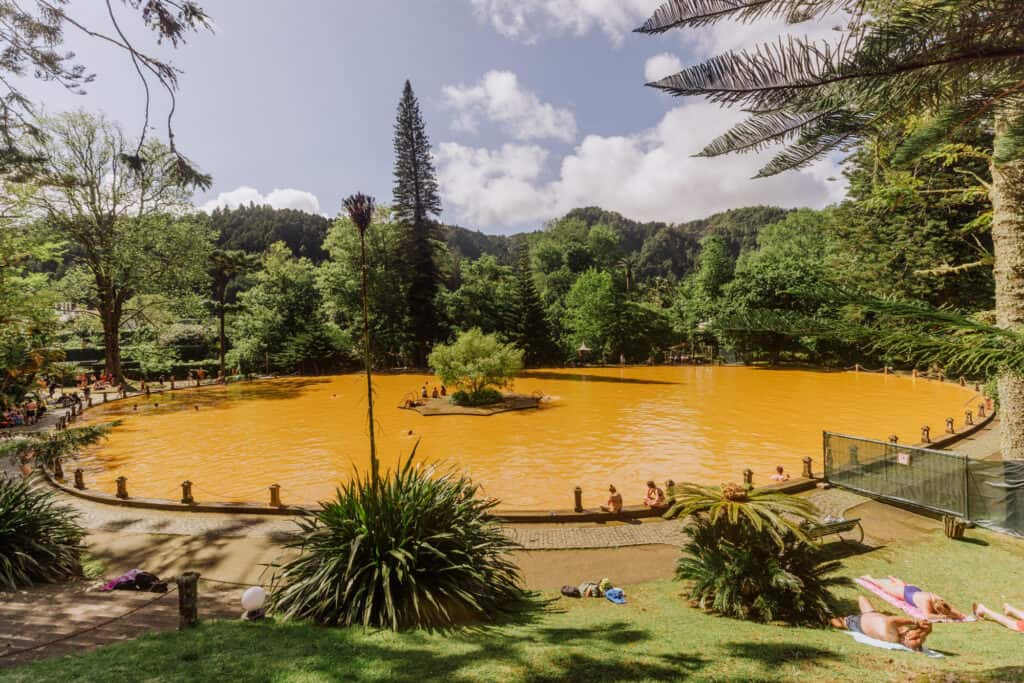
The thermal waters at Terra Nostra are mineral-rich, containing elements such as iron, sulfur, calcium, and magnesium.
If you’re not staying at the hotel and just visiting during “public hours,” expect to be part of a large crowd. Locals and tourists fan out across the grassy hillside surrounding the hot springs and make a day of it!
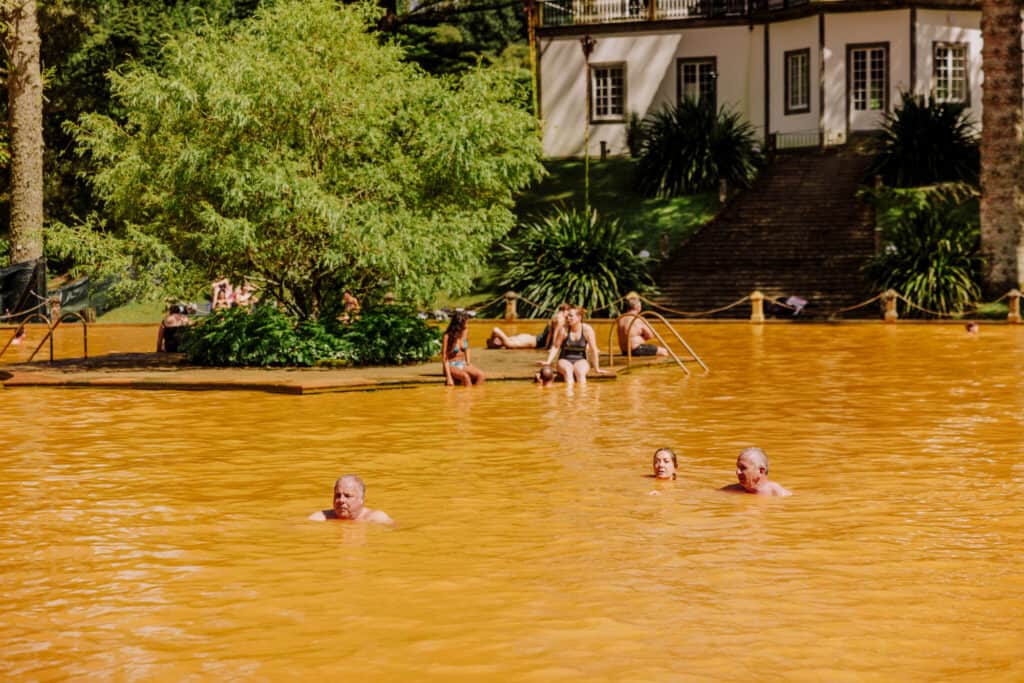
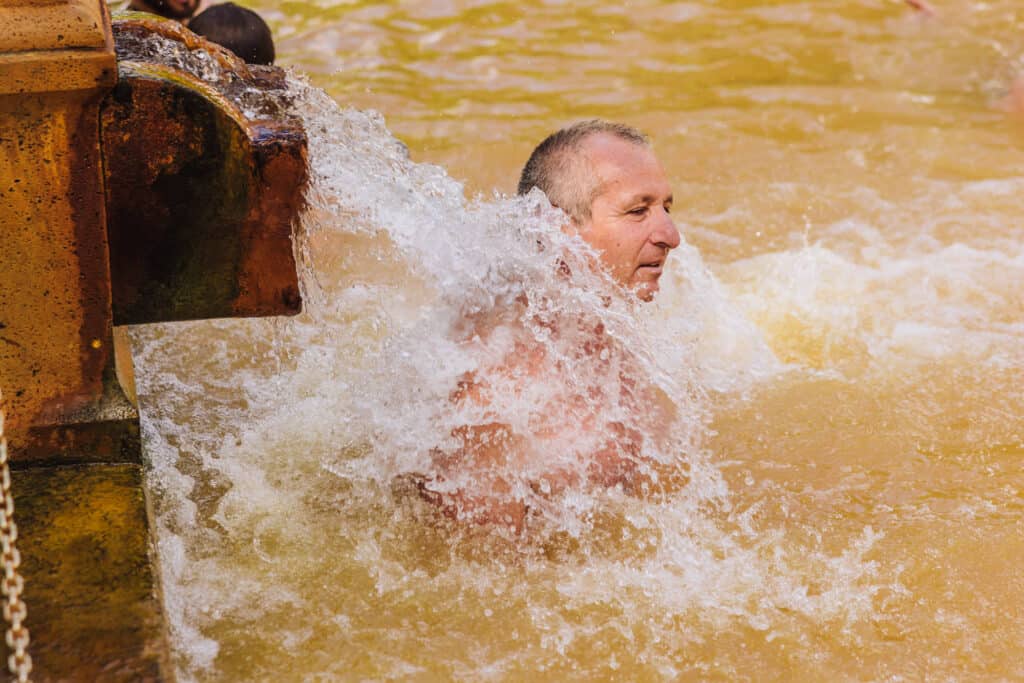
PRO TIP: The botanical garden is 30 acres, and includes trails and pathways lined with lush landscaping which I enjoyed more than the hot springs!
Water Temperature:
- 37 degrees Celcius (99 Fahrenheit)
Terra Nostra Hot Springs Cost:
- 10 Euros
Terra Nostra Hot Springs Hours:
- Park, grounds, and hot springs are open to the public: 10:00am – 4:30pm
- Hot springs are open to hotel guests until 11:00pm, though they’ll likely allow you to bathe 24/7
Amenities:
- Bathrooms, changing rooms, and a hotel restaurant
Hotel Nearby
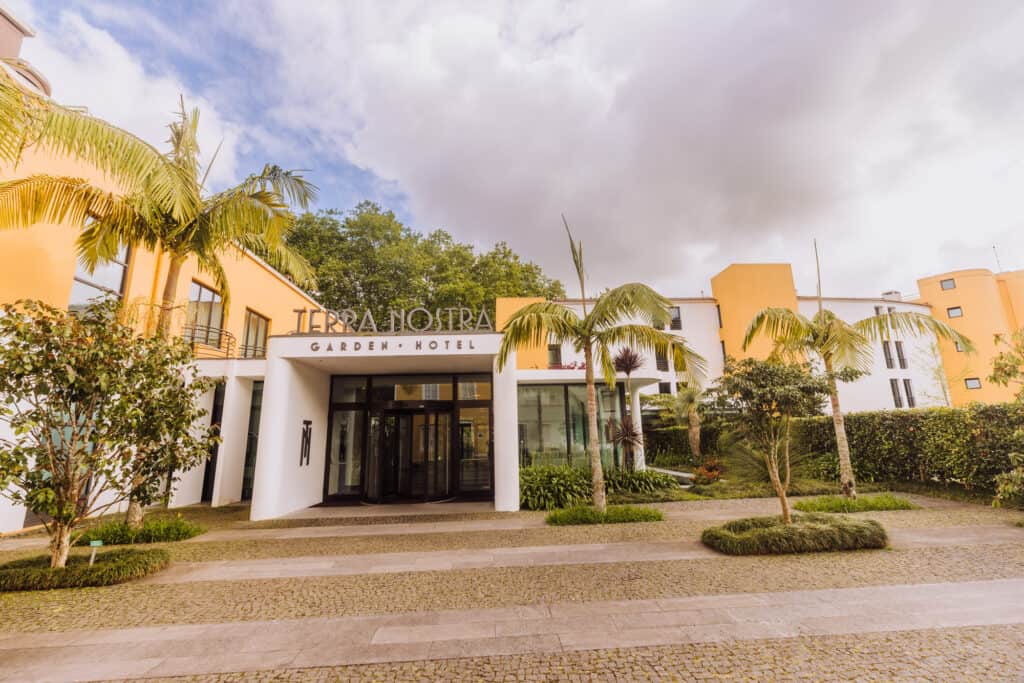
3. Caldeira Velha Hot Springs & Natural Monument
The Caldeira Velha hot springs are an interesting experience, up in the mountains closer to Ponta Delgada. It’s about a 30-minute drive from the city.
As you drive higher in elevation, you’ll actually start to see steam venting from the earth on the side of the road:
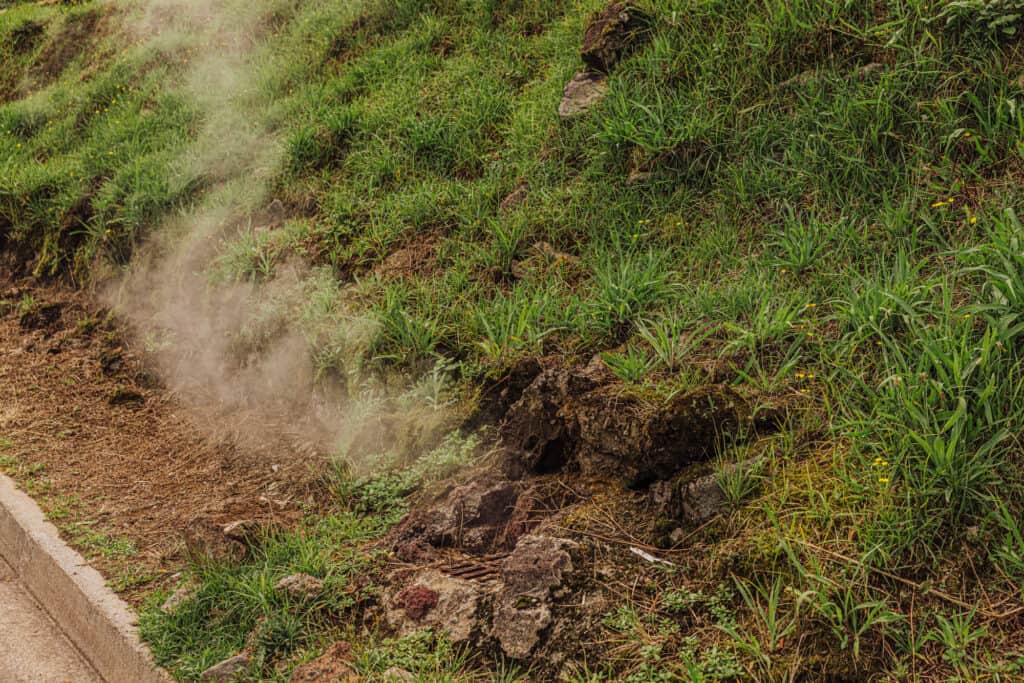
There are three pools and a waterfall, which are part of this Azores hot springs experience.
Each person gets 90 minutes in the Caldeira Velha hot springs. You’ll see people of all ages, including babies in the thermal pools.
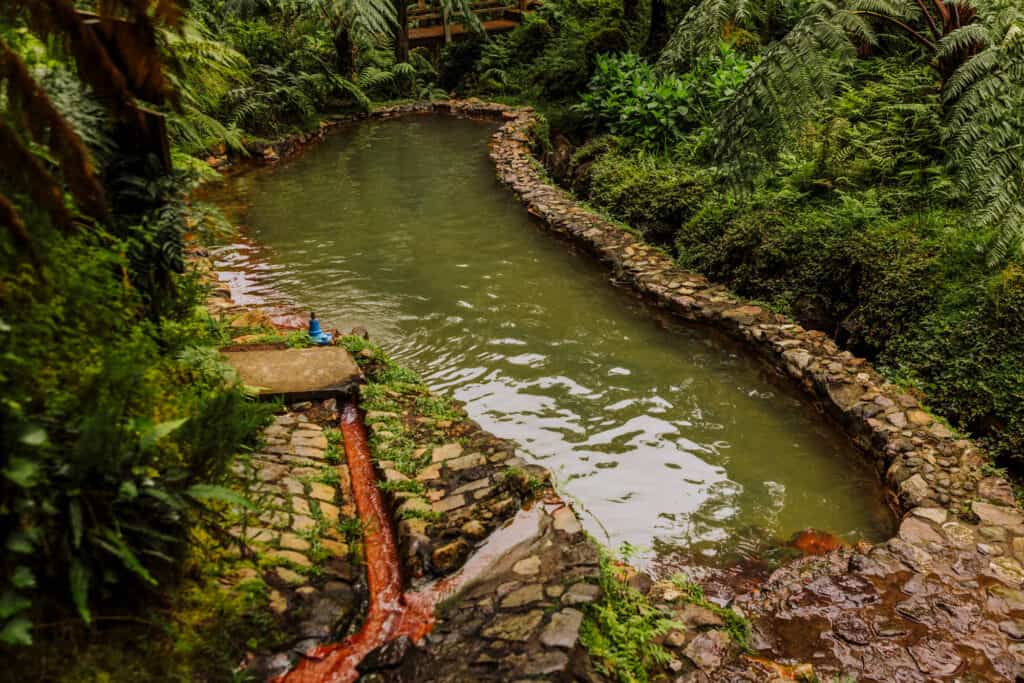
It’s interesting to see a pool of boiling water and mud off to the side, which is off-limits and dangerous to touch. The boiling water flows down into the bath area.
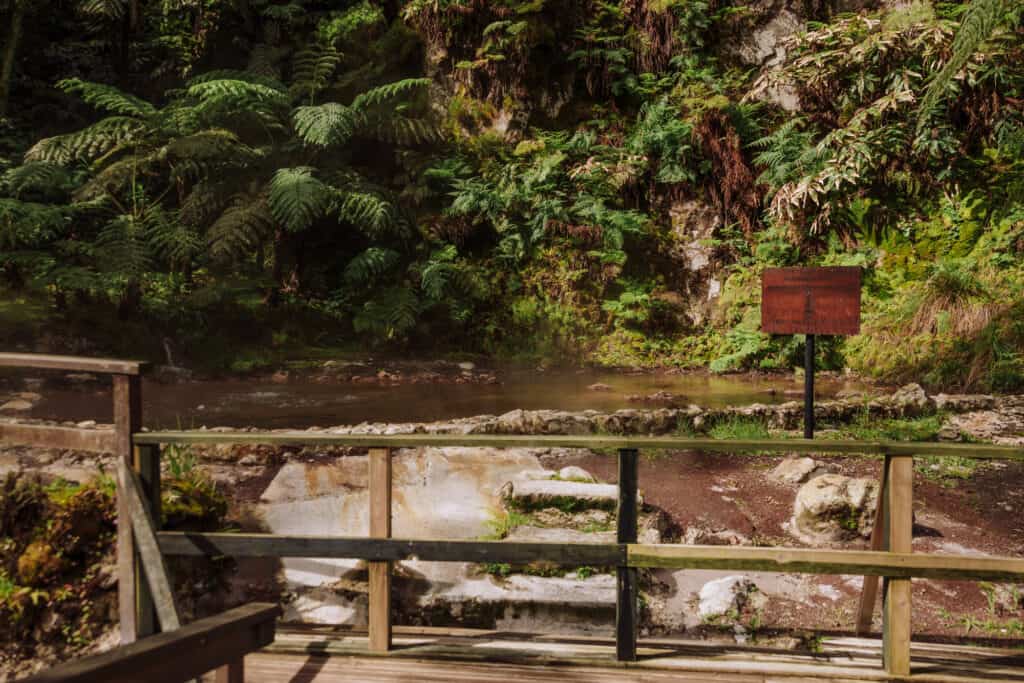
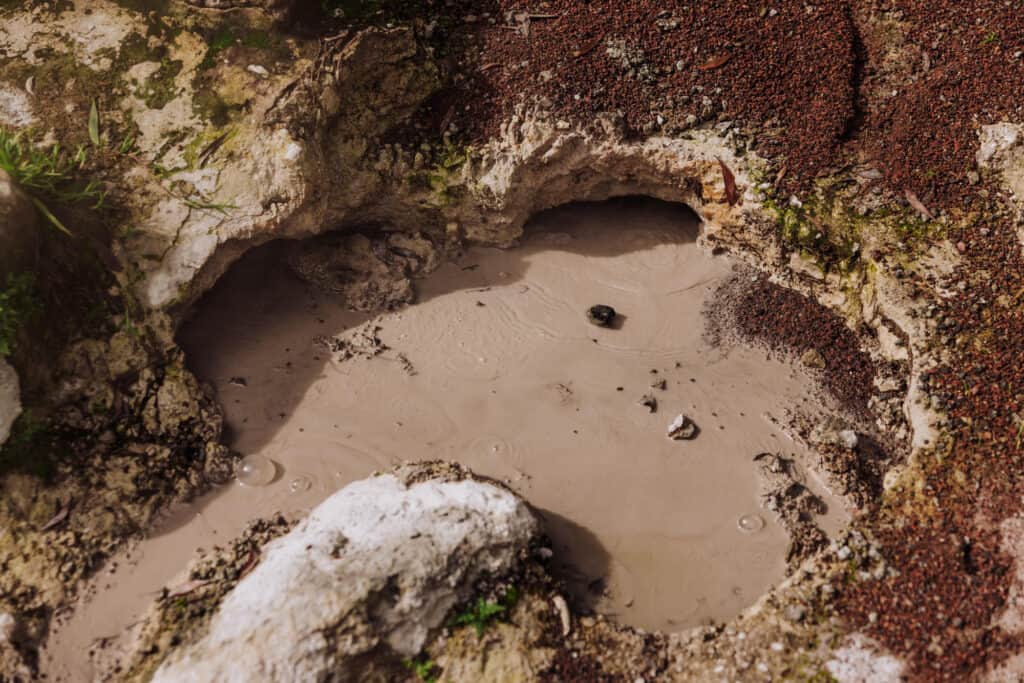
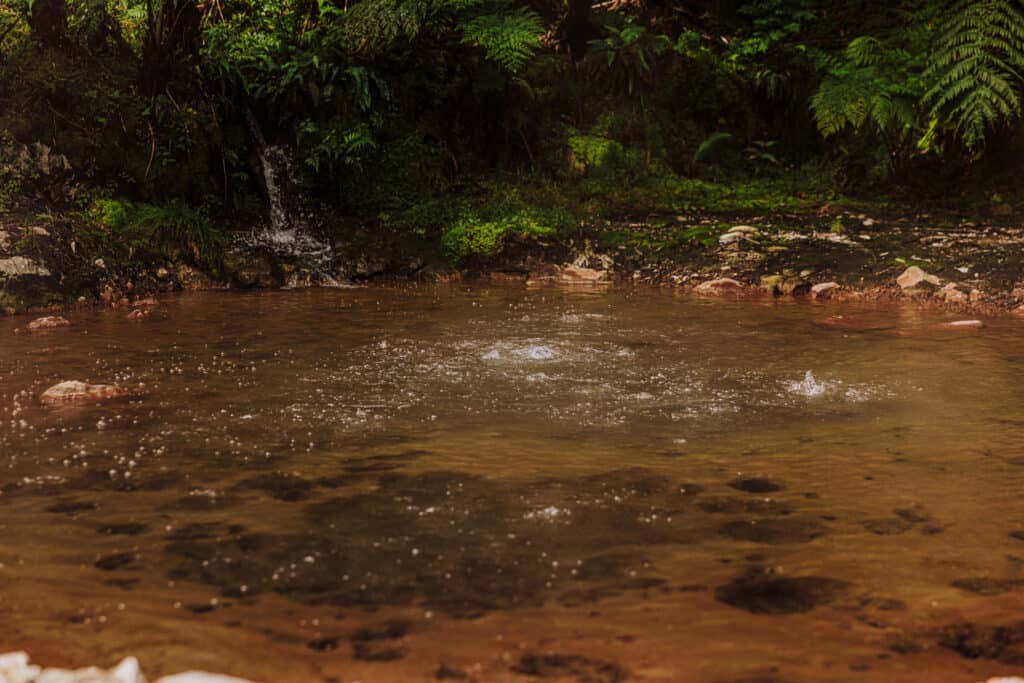
Caldeira Velha is a slightly more “natural” experience than Terra Nostra, since it’s surrounded by lush forest and frogs in the creek.
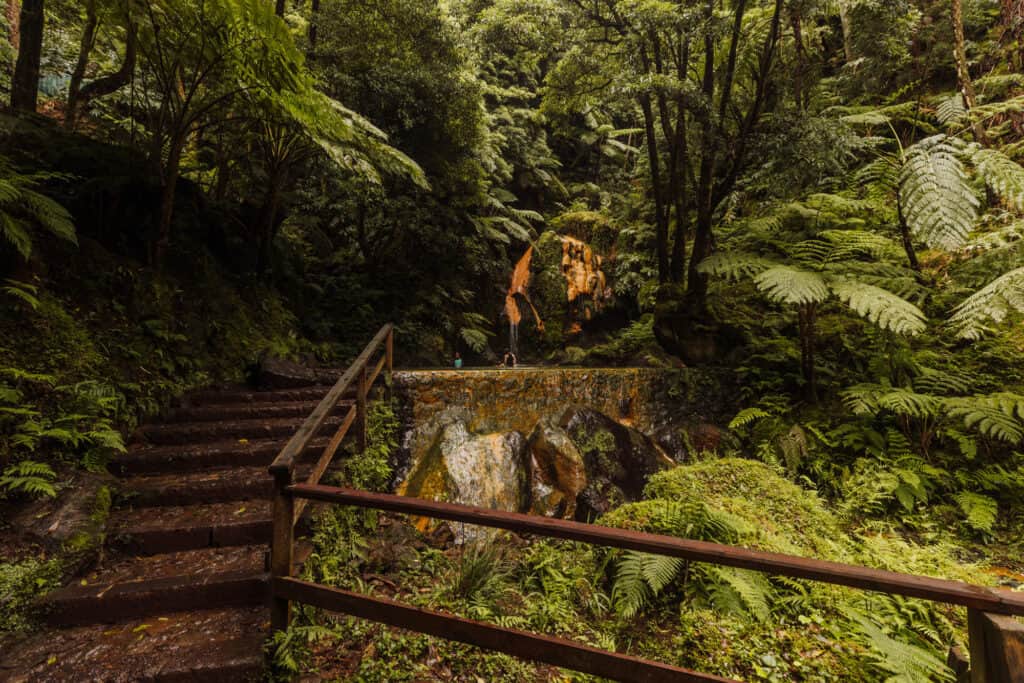
People bathing in the hot springs are surrounded by others who are just walking around the park. You don’t have to book ahead if you’re just looking to walk through the small park area.
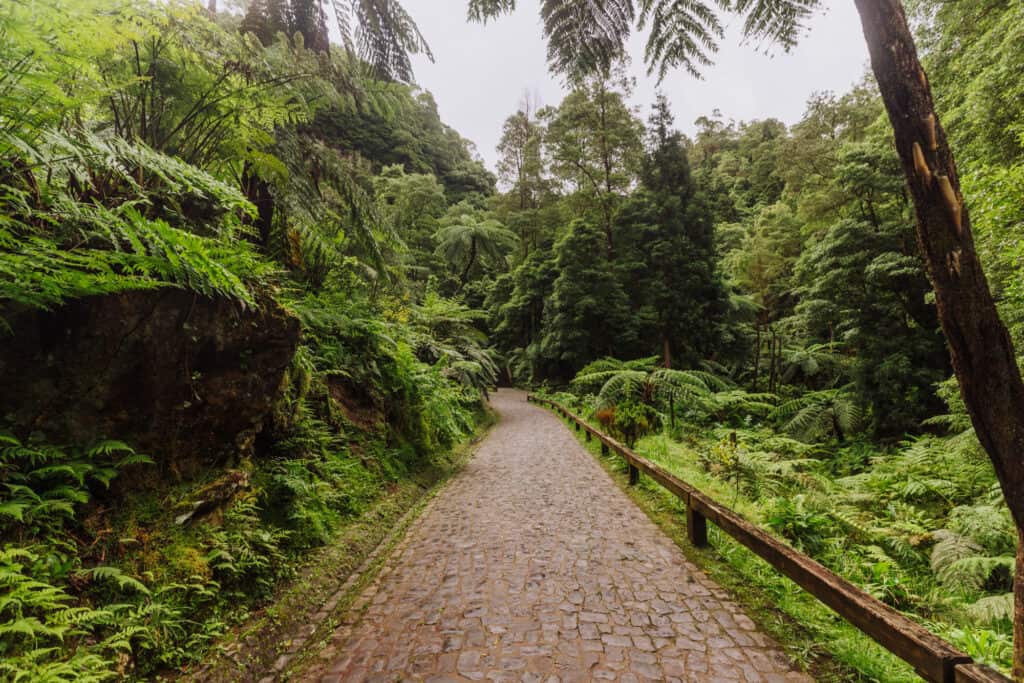
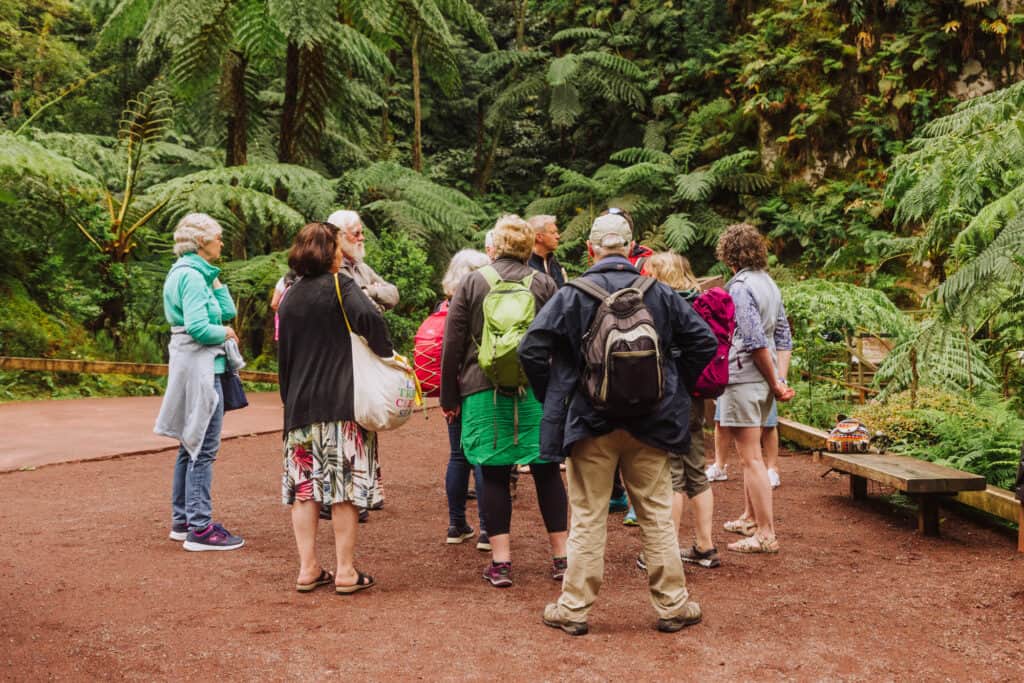
On the far end of the trail, you’ll find the prettiest spot: a big waterfall and swimming pool at its base. The water here is *not* warm. It’s about three-feet deep, and sort of murky, but definitely a nice area to explore. It’s also less-crowded since the water isn’t that warm.
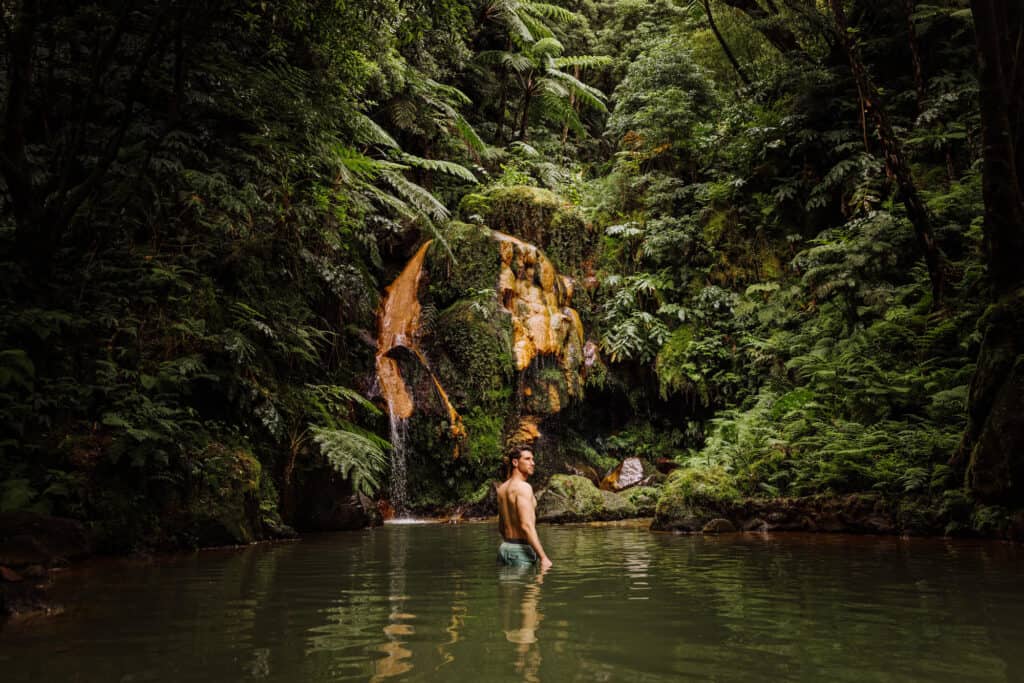
PRO TIP: Book a day in advance! You *have* to book a day ahead (for some reason) to swim in the Caldeira Velha hot springs.
I did appreciate the large parking lots and the food truck outside the Caldeira Velha park entrance.
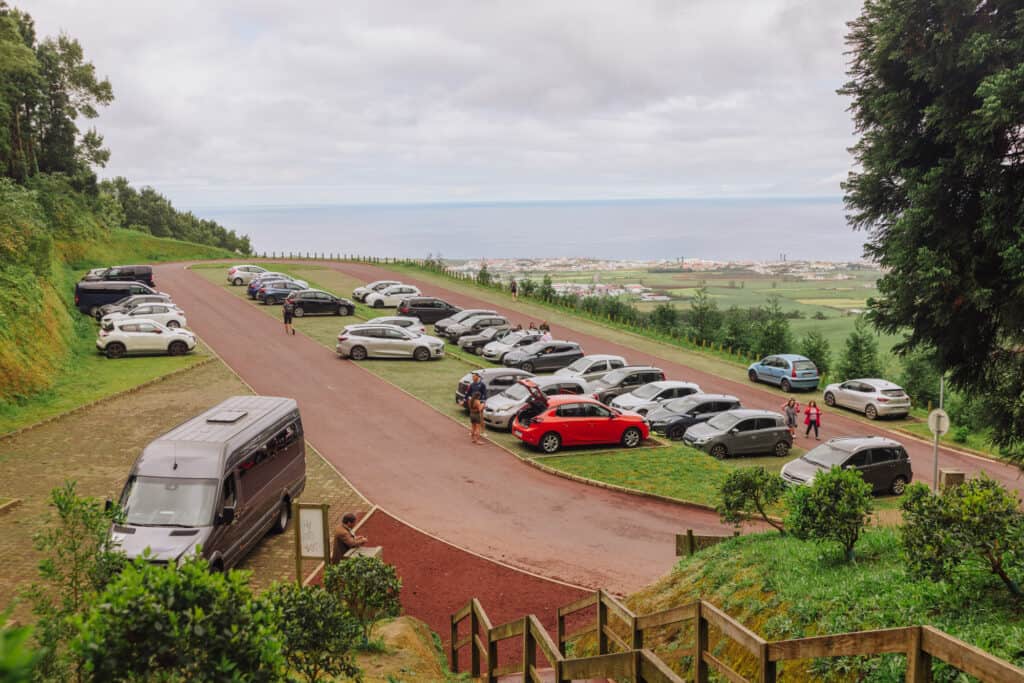
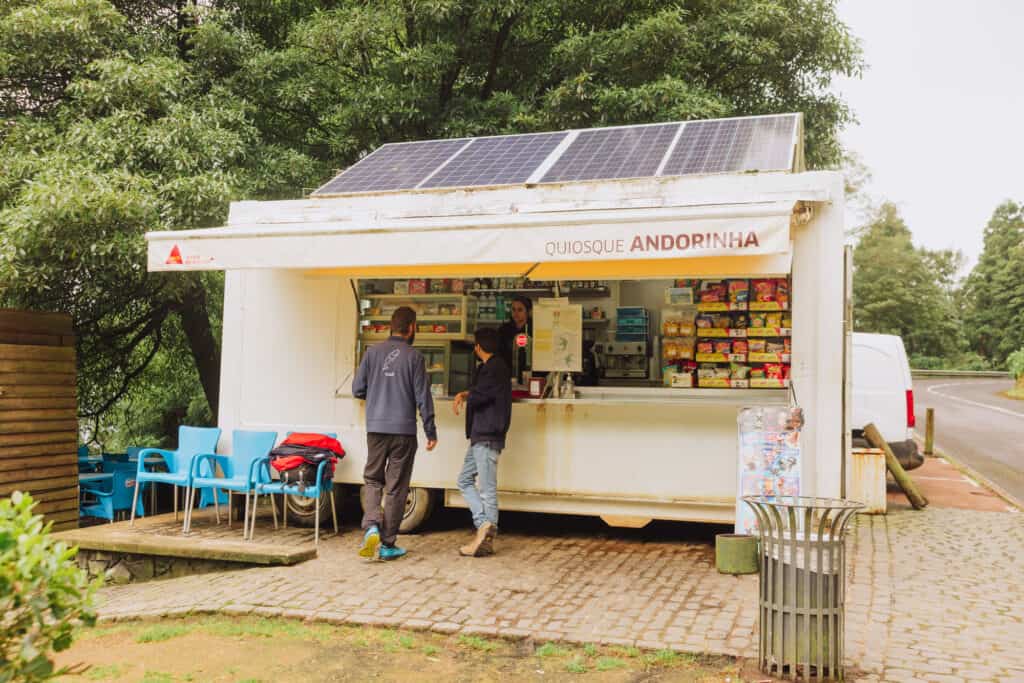
Water Temperature:
- As high as 38 degrees Celcius (99 Fahrenheit) in the thermal pools
- The water in the upper pool with the waterfall is around 24 degrees Celcius (mid-70s Fahrenheit)
Cost of the Caldeira Velha Hot Springs:
- Adults: 10 Euros
- Seniors: 5 Euros
- Kids 7-14: 5 Euros
- Resident of the Azores: FREE
- Park admission (no hot springs): 3 Euros
- Locker: 2 Euros
Caldeira Velha Hours:
- November through March: 9:00am – 5:00pm
- April: 9:00am – 6:30pm
- May through September: 9:00am – 8:30pm
- October: 9:00am – 6:30pm
- Again, remember to book the day before your visit!
Amenities
- Lockers, changing rooms, showers, interpretive center, snack truck
Hotels Nearby:
4. Ponta da Ferraria Hot Springs
Ponta da Ferraria is one of the major natural attractions on the western coast of São Miguel Island. You’ll find it near the small old fishing village of Ginetes, approximately 20 kilometers west of Ponta Delgada.
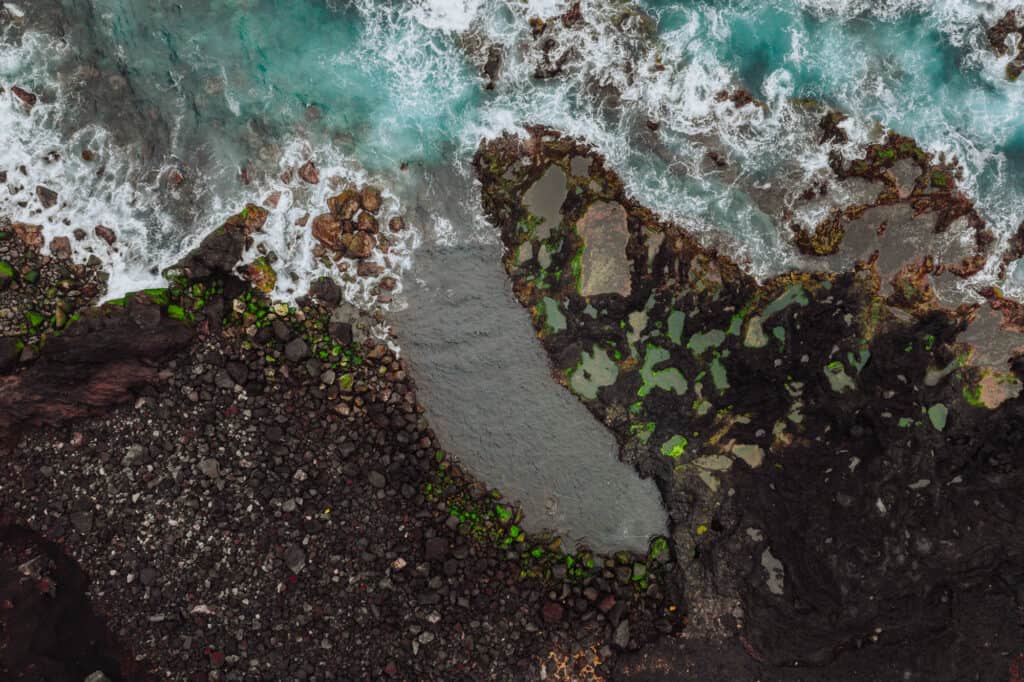
This is the biggest, best, truly *natural* Azores hot spring, made entirely of a volcanic rock pool adjacent to the Atlantic Ocean.
The hot water from the springs mixes with the colder seawater, providing visitors with various temperature options. If you time it right, you can enjoy a warm soak while feeling the refreshing ocean waves crashing nearby.
The location is stunning, at the base of the cliffs, and at the end of a trail.
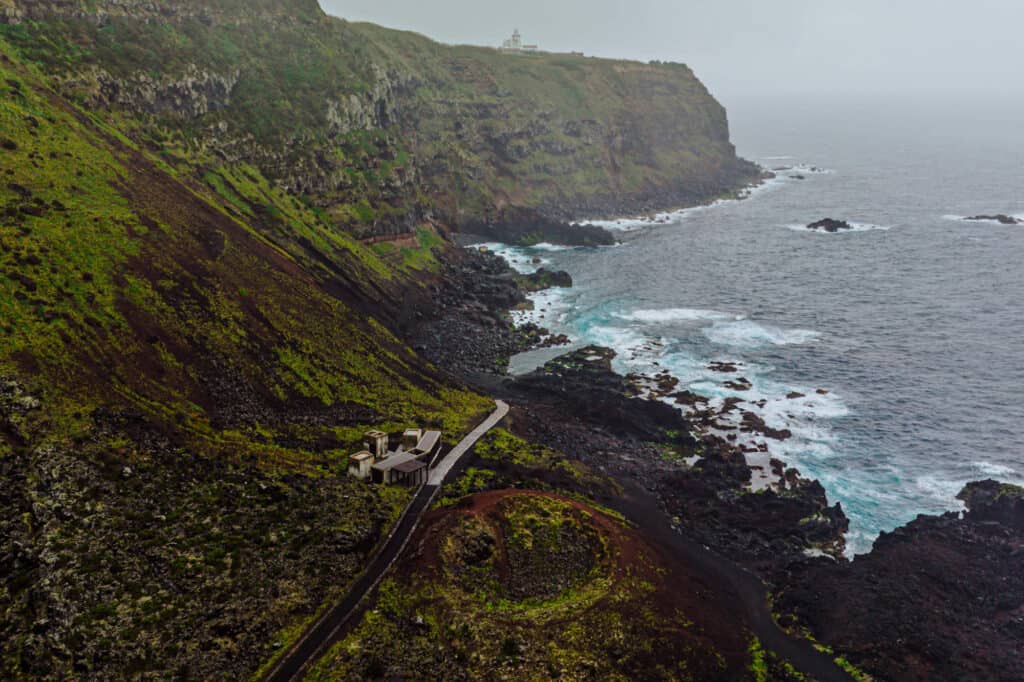
The ocean waves are often too strong at high tide to enjoy the hot springs. They can come crashing into the natural pool, and send bathers into the surrounding rocks. There’s a series of ropes which stretch across the water for you to hold onto, as the currents and waves go in and out.
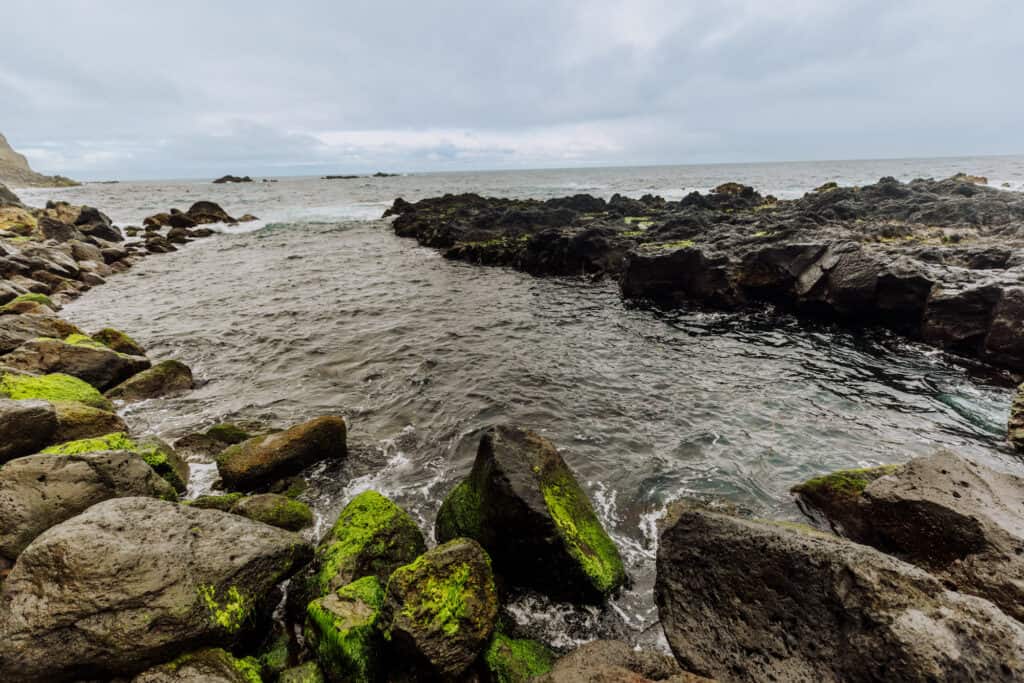
The temperature of the hot springs at Ponta da Ferraria can vary, depending on how much seawater mixes with the thermal water. At high tide, it’s lukewarm.
Other times, temperatures range from around 35 to 40 degrees Celcius (95 to 104 degrees Fahrenheit). During low tide, when there is less cold seawater mixing in, the pool is much hotter.
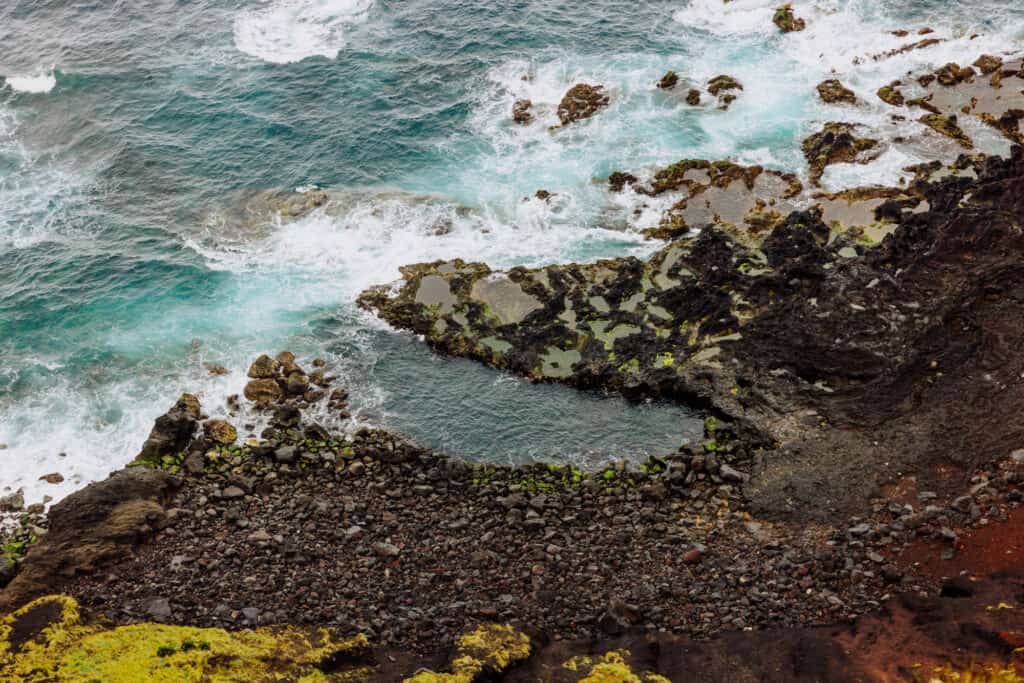
Ponta da Ferraria gets crowded in the summer, and a lifeguard is often on duty during peak season.
Apart from the hot springs, Ponta da Ferraria offers picturesque coastal views with dramatic cliffs and rugged volcanic rock formations. It’s a great place for a walk on the beach!
PRO TIP: Visit Ponta da Ferraria in the four-hour window around low-tide, for the best conditions in the hot springs.
For being in such a rustic, natural environment, you’ll find some nice amenities at Ponta da Ferraria, including bathrooms, showers, and changing areas.
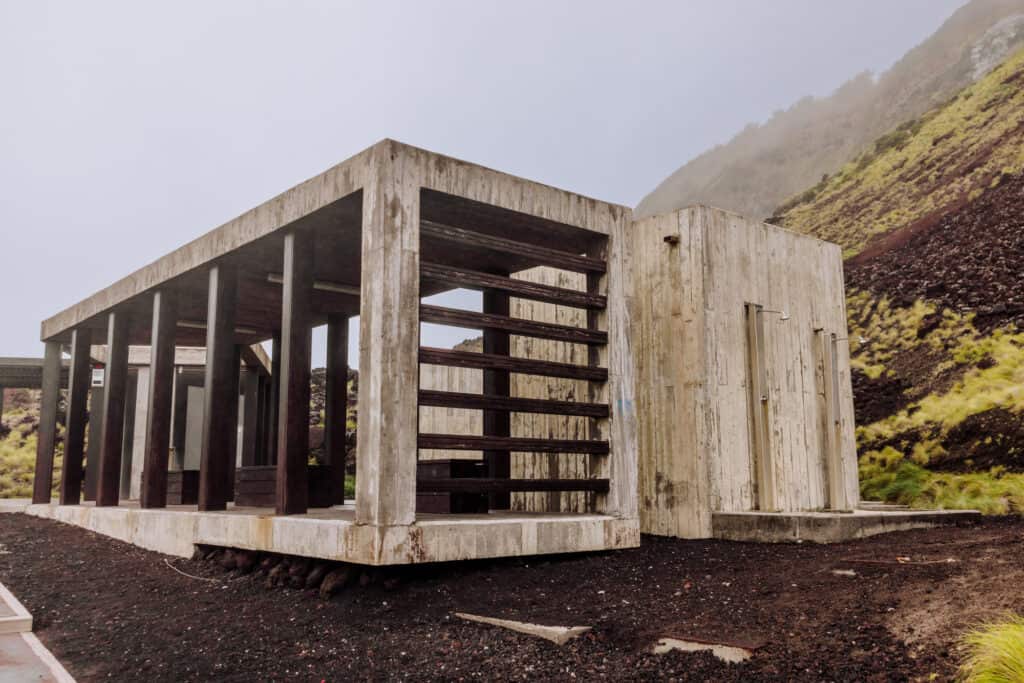
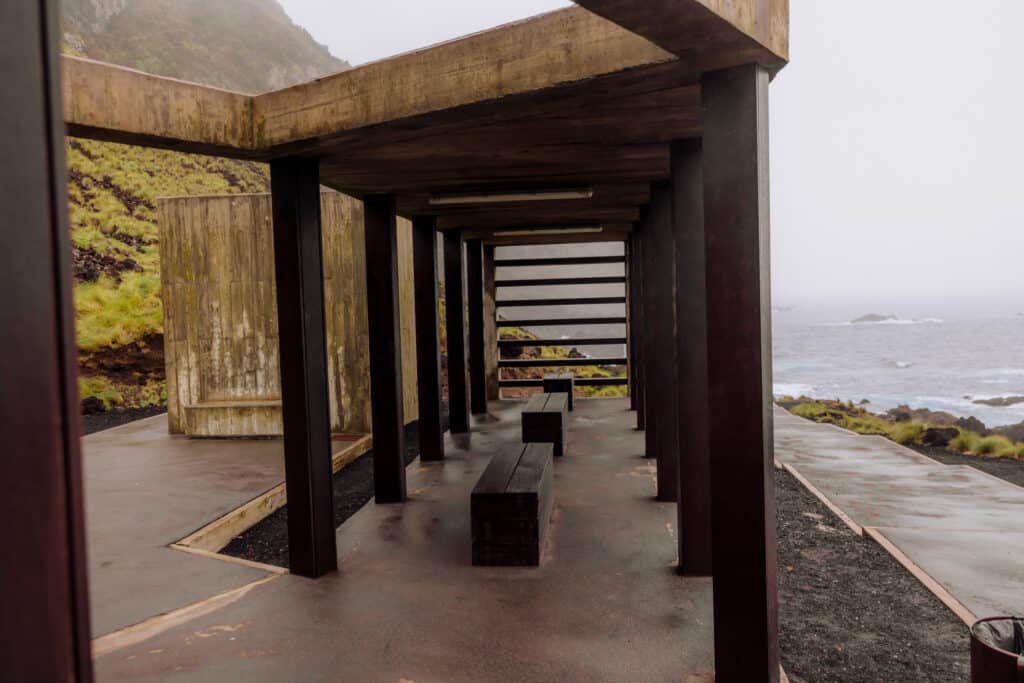
Ponta da Ferraria is a short walk down a path to a more commercialized hot spring experience, called Termas, which I’ll go over in the next section.
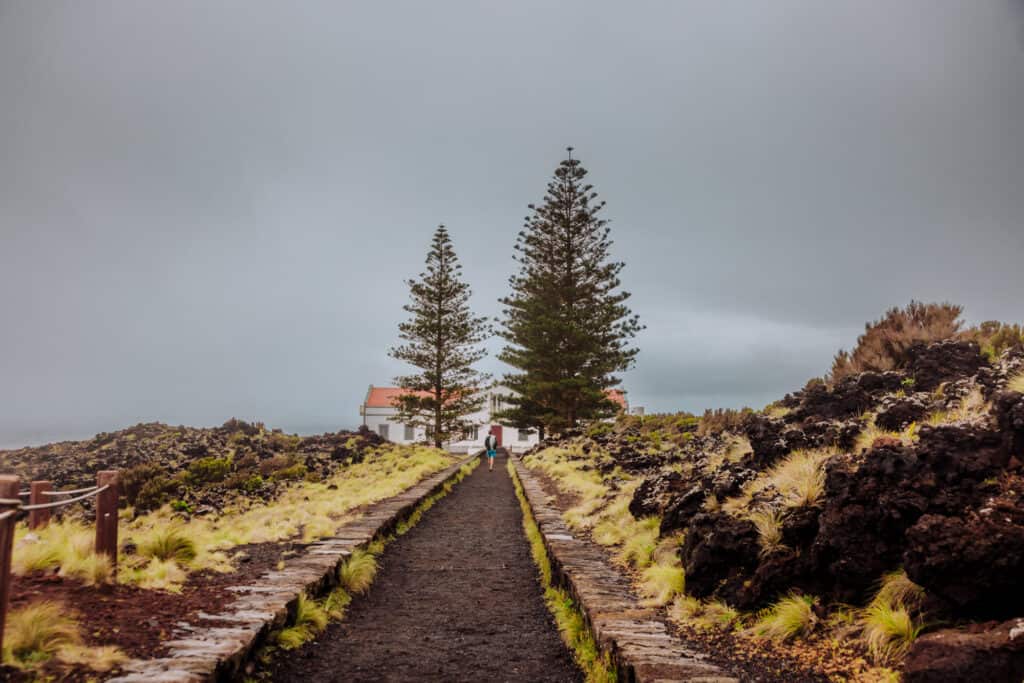
Water Temperature:
- Geothermal water: 35-40 degrees Celcius (95-104 degrees Fahrenheit)
- Ocean water: 60-75 degrees Fahrenheit, depending on the season
Ferraria Hot Springs Cost:
- Free
Ferraria Hot Springs Hours:
- 24/7
Amenities:
- Changing rooms and bathrooms
Hotel Nearby:
5. Termas da Ferraria Spa
Termas, which translates to “thermal baths” in Portuguese, refers to the geothermal hot springs found in this area. The Termas da Ferraria Spa is a commercialized, man-made version of the natural hot springs pool down the beach.
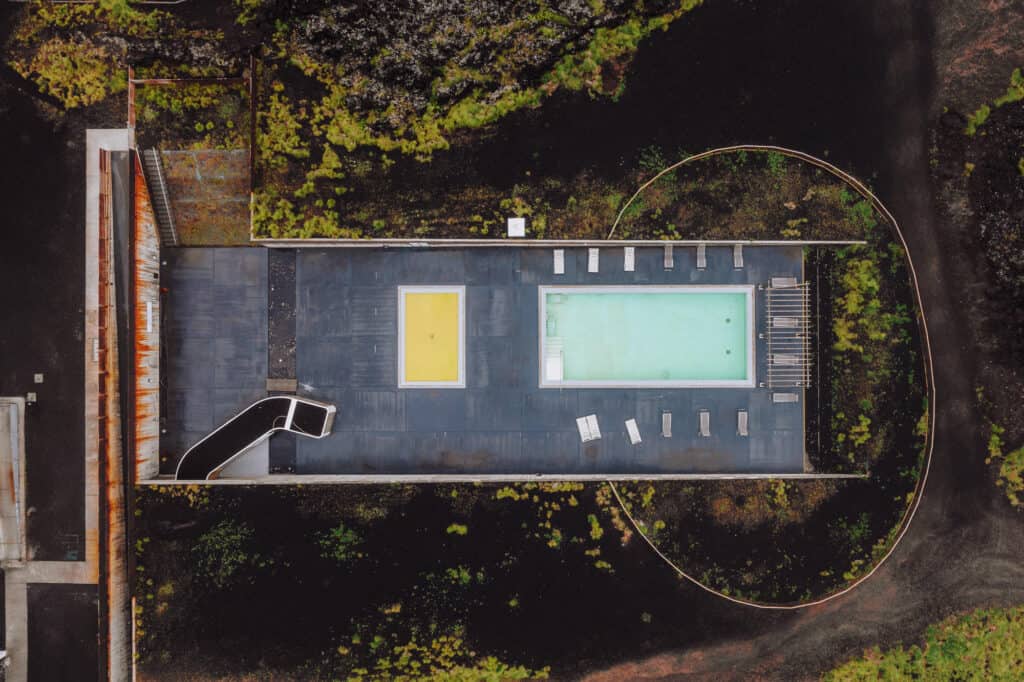
Termas da Ferraria offers visitors the opportunity to relax and bathe in the geothermal waters, which are said to have therapeutic properties from the mineral content. A large manmade pool is filled with the geothermal waters from the nearby hot springs.
It’s part of this property, which is in a truly stunning location on the west coast:
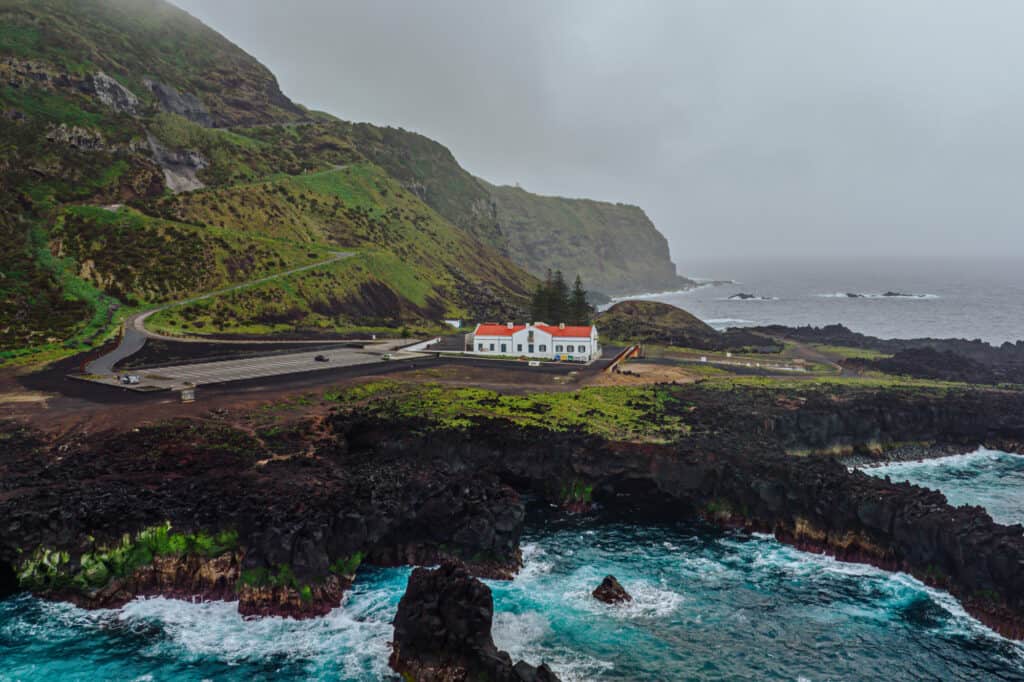
In addition to the thermal pool, you can book massages and other wellness treatments. Relaxing massages start at 35 Euros.
The Termas da Ferraria Spa may provide other amenities such as changing rooms, showers, relaxation areas, and a restaurant.
Contact:
Hours:
- Tuesday through Sunday
- 11:00am to 7:00pm
Hotel Nearby:
What Makes the Azores Hot Springs Unique
- Thermal Diversity: The Azores boasts a wide range of hot springs with different temperatures and mineral compositions. Some springs are extremely hot, while others are comfortably warm.
- Natural Setting: The hot springs in the Azores are often nestled in stunning natural landscapes. Many of them are surrounded by lush vegetation, scenic mountains, or overlook the ocean.
- Mineral-rich Waters: The thermal waters of the Azores are known for their mineral content. The geothermal activity leaches minerals from the volcanic rocks, enriching the hot springs with various beneficial elements such as sulfur, iron, calcium, and magnesium.
- Accessibility: Unlike some other geothermal regions, the hot springs in the Azores are relatively accessible. Many of them are located near towns or tourist areas, making it convenient for visitors to experience the natural hot springs.
- Cultural Significance: Hot springs have been a part of the Azorean culture for centuries. The locals often view these natural thermal baths as places of healing and rejuvenation.
You can learn more about the Azores hot springs at an interpretive center, located at the Caldeira Velha location.
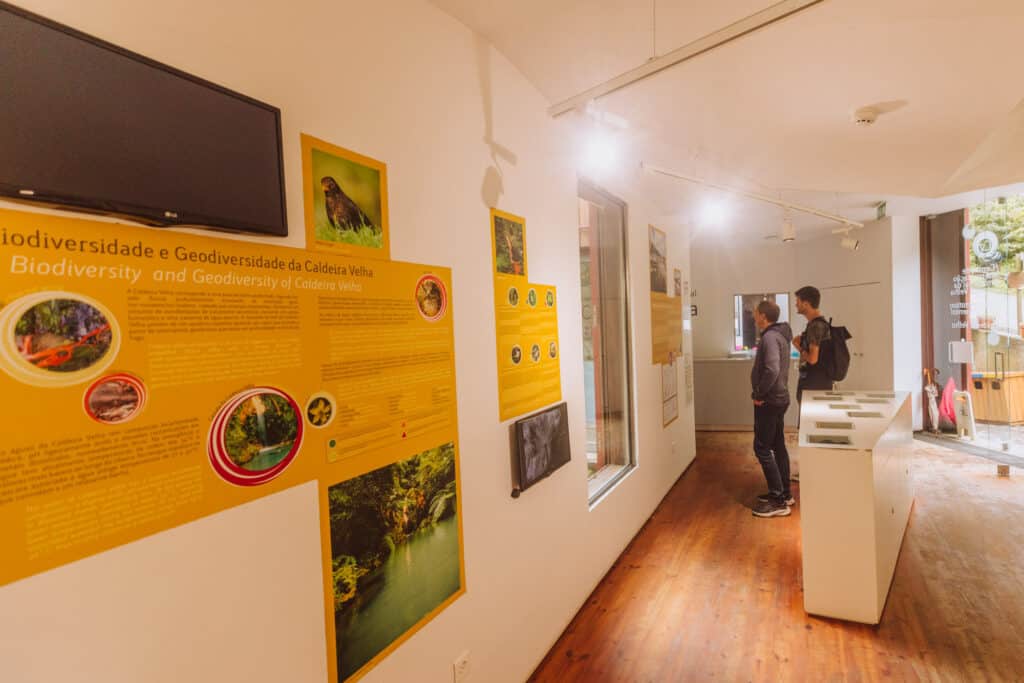
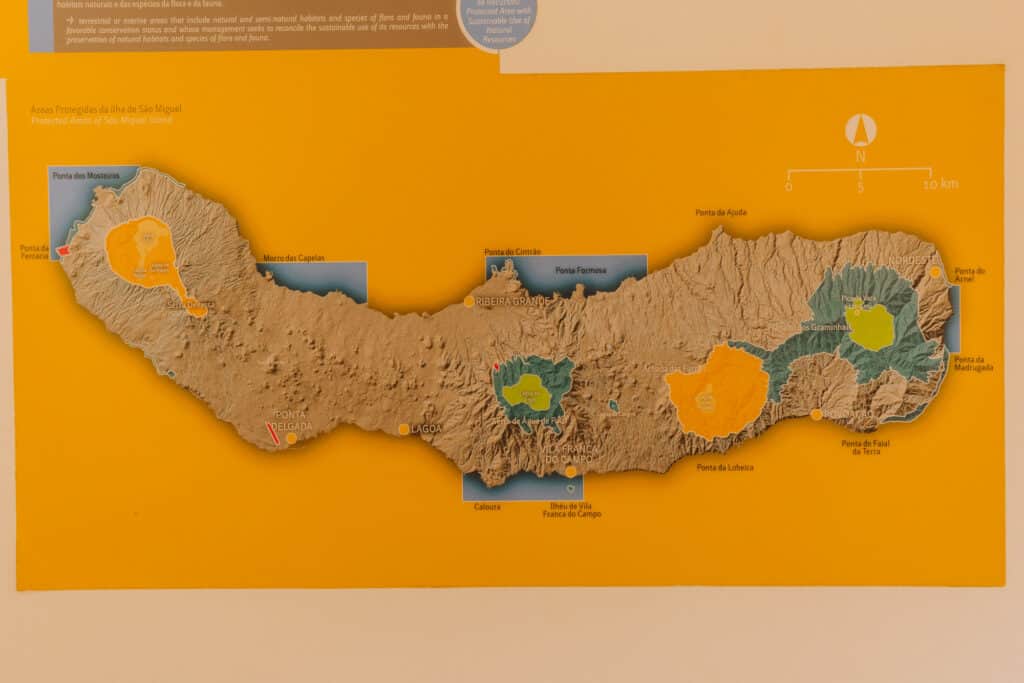
Health Benefits of the Azores Hot Springs
Sao Miguel’s hot springs are believed to benefit your physical and mental health. In addition to just the pure relaxation some of them can offer, the hot mineral water is also touted for these healthy benefits:
- Improved Circulation: The heat from the hot springs dilates blood vessels, which can enhance blood circulation throughout the body. This improved circulation may help deliver oxygen and nutrients to the muscles and organs more efficiently, promoting overall health and well-being.
- Pain Relief: The mineral-rich waters of the hot springs, particularly those containing sulfur and other therapeutic minerals, are often associated with pain relief. Soaking in these waters may help alleviate symptoms of conditions such as arthritis, muscle aches, and joint stiffness.
- Skin Health: The minerals present in the hot springs, such as sulfur and silica, are known to benefit the skin. These minerals can help improve skin hydration, promote collagen production, and soothe skin conditions like eczema and psoriasis. Bathing in hot springs may leave the skin feeling smoother, softer, and rejuvenated.
- Respiratory Health: The steam and mineral content in the hot springs can have a positive impact on respiratory health. The warm, moist air can help open up the airways, making it easier to breathe for individuals with respiratory conditions like asthma or allergies.
- Detoxification: The minerals in the hot springs are believed to have detoxifying properties. They may help draw out toxins from the body and promote the elimination of waste through sweating.
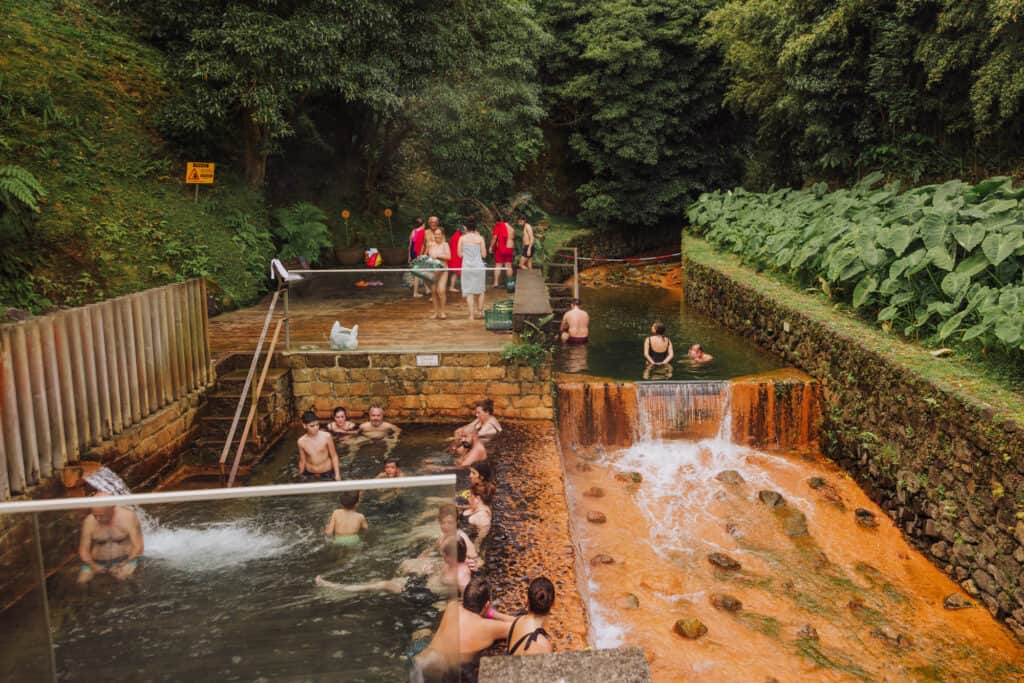
Natural Pools on São Miguel
In addition to São Miguel’s hot springs, the island is also home to a number of natural pools which are *not* heated.
Santo Antonio Natural Pool
On the north shore of Sao Miguel, you’ll find Piscinas Naturais de Santo António on the map.
After parking near the church and cemetery in this old fishing village, you’ll walk down to the ocean and find a natural pool along the coast. Going at high-tide will provide a much prettier experience, as low tide is kind of lackluster.
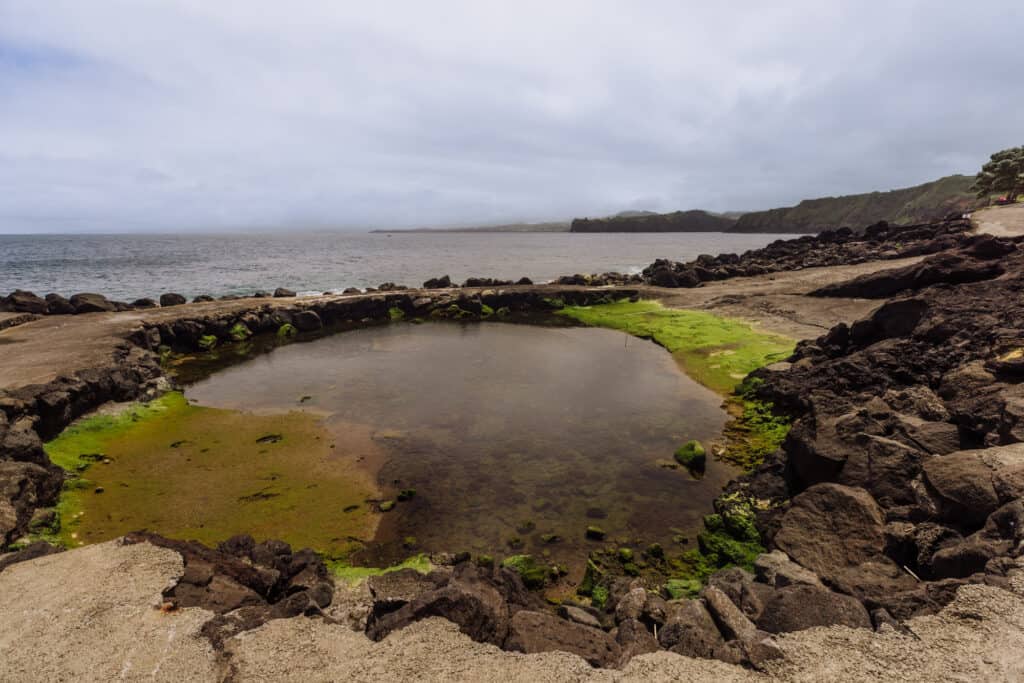
Pocos de Sao Vicente
Locals say the natural pool here was used years ago by whalers, bringing sperm whales in to be processed. The old whaling factory was across the street. You can still see the smokestack and remnants there today.
The natural pool itself is popular with snorkelers. There are steps built down into it, and it’s protected by rocks from the big waves in the ocean.
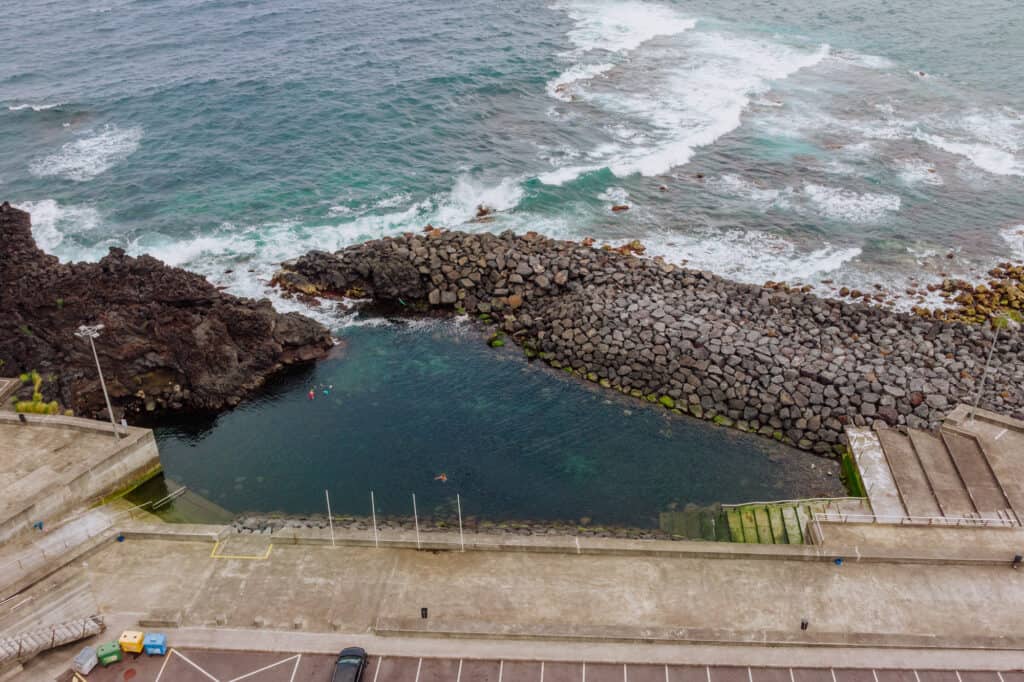
Mosteiros
Mosteiros is home to the most “natural” pool of all. It’s literally a deep pool in the volcanic rocks on the beach, which fills with water. It’s clear, and deep enough to jump into.
The natural pool here is behind the popular “Sunset Steve’s” snack shack in the parking lot on the cliff overlooking the ocean.
It’s surrounded by smoother volcanic rock, which you can lay out on during the sunny summer days.
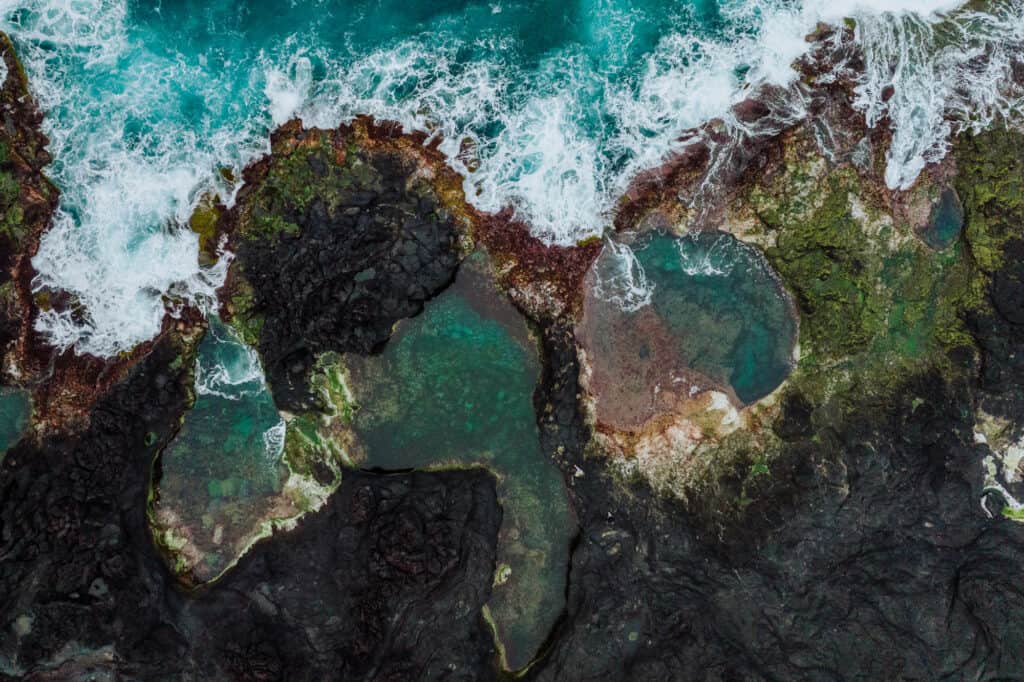
When to Visit the Azores Hot Springs on São Miguel
The Azores’ hot springs can be visited year-round, and the best season depends on your interests.
- Spring (March to May): Spring in the Azores is mild, so it’s a great time to visit the hot springs while tourist crowds are much smaller than the summer months.
- Summer (June to August): Summer in the Azores is the peak tourist season. The weather is beautiful, and the days are long. The hot springs can be much more crowded in the summer. If you don’t mind the crowds, summer is a great time to visit the Azores’ hot springs.
- Autumn (September to November): Autumn in the Azores brings mild temperatures and occasional rainfall, and the tourist crowds start to taper off. Visiting the Azores hot springs during the fall months provides a more peaceful experience, while the weather is still generally decent.
- Winter (December to February): Winter in the Azores is cooler and rainy, but it never snows. A winter visit to the Azores hot springs can be a cozy and relaxing experience, with far more peace and tranquility with smaller crowds.
CHECK OUT OUR OTHER GUIDES TO THE AZORES:
